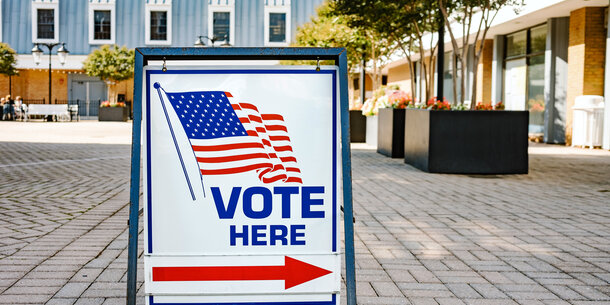On March 2, the Supreme Court will hear oral arguments in a challenge to a pair of Arizona voting policies that make it harder for people to vote, especially in communities of color and Native American communities. The case, Brnovich v. Democratic National Committee, is significant because it likely won’t just affect voters in the state. It could have broad implications for the fairness of our democracy across the country because of what the decision might mean for the Voting Rights Act of 1965, known as the VRA.
The Brennan Center and other groups are urging the court to enforce and preserve the VRA’s protections, which were previously scaled back by a damaging 2013 Supreme Court ruling. Now, in the midst of an expanded, nationwide voter suppression push fueled by lies about nonexistent fraud in the 2020 election, those safeguards have taken on even greater importance — and so has this lawsuit.
What is the case about?
In 2016, the Democratic Party and a group of individual voters filed suit in federal court to challenge two Arizona policies as racially discriminatory. The first is an “out-of-precinct” rule that any vote cast in the wrong polling place must be tossed out, even if it is for president, governor, or some other race in which the voter could have cast a ballot anywhere in the state. The other is a ban on collecting and turning in mail ballots by anyone other than a voter’s immediate family members or caregivers.
The plaintiffs challenged these policies under Section 2 of the VRA and the 15th Amendment, both of which bar voting policies and practices that discriminate based on race. They lost in the trial court but won on appeal. The Ninth Circuit Court of Appeals found that both policies resulted in discrimination and that the ballot collection prohibition was passed for a racially discriminatory purpose. Arizona Attorney General Mark Brnovich and the Arizona Republican Party asked the Supreme Court to take up the case.
Why did the appellate court find Arizona’s policies to be discriminatory?
The Ninth Circuit found that both of Arizona’s policies amounted to illegal discrimination because of how they made it harder for people of color to vote given the specific circumstances in the state. In other words, the court did not rule that a policy of disregarding out-of-precinct ballots or limiting ballot collection is always discriminatory — just that these specific policies were discriminatory in Arizona.
Voters can sue under Section 2 of the VRA whenever minority voters “have less opportunity than other members of the electorate to participate in the political process and to elect representatives of their choice.” They do not have to prove that a policy was passed for a discriminatory purpose, only that it led to these discriminatory results.
In this case, the court noted that Latino, Native American, and Black voters in Arizona have their ballots rejected for being out-of-precinct reason far more often than their white counterparts. The court found that this was because poll locations were moved around very frequently in Arizona’s communities of color and were often located in counterintuitive places near the edges of precincts. Adding to the burden was the fact that voters of color move more often.
The court also noted that voters of color and Native American voters were more likely to rely on ballot collection than white voters for reasons that are especially present in Arizona. For example, the significant population of Native American voters living on reservations often reside far from polling places and have nontraditional addresses and limited mail access.
Further, the court found that the ballot collection policy was enacted in order to take advantage of these disparities and target voters of color. Among other things, the court noted that the policy had been passed based on false rhetoric about rampant voter fraud. The so-called “evidence” of voter fraud that motivated the legislature was a video showing surveillance footage of a Latino man dropping off ballots with a voiceover describing him as a “thug” and suggesting he might be an undocumented immigrant.
Why is this case significant?
It’s certainly important for stopping voter suppression in Arizona. But its significance reaches far beyond Arizona’s borders because the case concerns the VRA, one of the most successful civil rights laws in our nation’s history. Brnovich, the Republican Party, and a number of others that filed friend-of-the-court briefs have used the case to ask the Supreme Court to seriously limit on VRA Section 2, which allows voters and advocates to challenge racially discriminatory policies and practices. Any decision weakening Section 2 would make it much harder to stop voting discrimination in the future.
What is Section 2 of the Voting Rights Act and why is it so important?
Section 2 prohibits states and localities from imposing any “qualification or prerequisite to voting or standard, practice, or procedure . . . in a manner which results in a denial or abridgement of the right of any citizen of the United States to vote on account of race or color[.]” It also allows voters to file suit to challenge discriminatory policies.
For many years, it was used primarily to combat schemes to dilute the voting power of communities of color through discriminatory redistricting and related plans. But it became even more important in 2013, when the Supreme Court dealt a major blow to a different piece of the law — Section 5 — in Shelby County v. Holder.
Under Section 5, states and localities with a history of race discrimination in voting were subject to “preclearance” of their voting policies and practices by the Department of Justice. That is, they had to run proposed changes in elections by the federal government and show that they weren’t discriminatory before putting them into effect. The preclearance process provided an incredibly effective means for preventing discrimination. In Shelby County, the Court held that the VRA’s formula for determining which jurisdictions would be covered by preclearance was outdated and as a result, unconstitutional. So even though Section 5 remains, by striking down the coverage formula the Court effectively ended preclearance.
The consequences of this decision have been palpable. Unencumbered by the preclearance process, previously covered jurisdictions enacted a series of laws and other measures that restrict voting. A number of states passed or implemented policies that had previously been blocked by preclearance.
The ballot collection prohibition in Arizona is a prime example. The state submitted the policy to the Department of Justice for preclearance in 2011. When the agency asked for more information, saying it was unable to determine whether the policy was discriminatory, the Arizona attorney general withdrew the policy from consideration for preclearance. As the Ninth Circuit Court of Appeals noted in its Brnovich opinion, “The Attorney General did so for good reason. According to DOJ records, Arizona’s Elections Director, who had helped draft the provision, had admitted to DOJ that the provision was ‘targeted at voting practices in predominantly Hispanic areas.’” But without preclearance in effect, Arizona was able to reenact the policy in 2016.
After Shelby County, it became incumbent on voters and their advocates to identify and challenge discriminatory policies in previously covered jurisdictions. And Section 2 is the primary tool they have to do so.
What could the Supreme Court do?
The justices are considering whether to leave Arizona’s voting restrictions in place. They do not have to reach beyond the facts of this case and depart from prior precedent about how Section 2 works to do so. However, many of the briefs filed in the case are asking the Supreme Court to make such a departure.
Even though Section 2 was designed to protect against policies that result in discrimination, some have asked the justices to limit it to policies that plaintiffs can prove were intended to discriminate. Some have asked the Court to limit the law only to challenges against policies that dilute votes, such as in cases of gerrymandering, making it impossible to bring the suits against voter suppression that have become more prominent since Shelby County. Some have even taken the radical position that Section 2 is unconstitutional in some way.
These attacks come as we are witnessing a new and unprecedented wave of restrictive voting legislation under consideration across the country. Already this year, over 253 restrictive bills are under consideration by legislatures in 43 states, compared to 35 such bills in 15 states a year earlier. We are also heading into a new redistricting cycle, and without Section 5 preclearance in effect, the threat of discriminatory maps is real. Unless Congress restores Section 5 of the VRA, Section 2 will remain the primary tool available to combat any racially discriminatory policies.
What should the Supreme Court do in order to safeguard voting rights?
The Court should reaffirm the role that the VRA plays in protecting voters of color, Native American voters, and our democracy, making clear that Section 2 will continue to operate as a check on discriminatory policies. In friend-of-the-court briefs, the Court has heard from a wide array of voices encouraging it to do just that.
In our brief, the Brennan Center explained how and why Section 2 requires courts to take account of racial reality by looking to the relevant social, political, and historical conditions in which voting rules and procedures operate.
A group of 70 state and local election officials from 38 states and the District of Columbia responded to claims that a robust Section 2 hinders legitimate election administration through the threat of litigation, showing how Section 2 actually supports their work.
More than 250 major corporations, individual CEOs, board directors, and business academics joined a brief arguing that the Voting Rights Act is fundamental to the health of America’s economy and markets.
In short, the Supreme Court should uphold the bedrock principles of fairness and equality that undergird our democracy and strike down Arizona’s racist voting restrictions.



